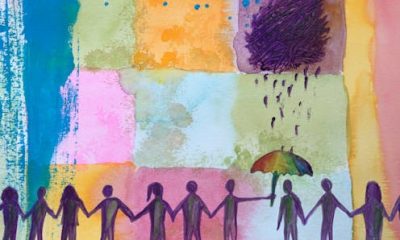
Jewish mothers have created ways to celebrate childbirth with rituals old and new. Pal Pillai/AFP via Getty Images
Reading the Torah, there is no doubt about motherhood’s important role in Jewish literature and life.
The Hebrew Bible is replete with stories of women who feel incomplete without children, although Orthodox interpretation holds that only men are commanded to “be fruitful and multiply.” Unable to bear children, Sarah offers her handmaid Hagar to her husband, Abraham, so he can father a child. Rachel longs for deliverance from infertility, saying “Give me children or I shall die,” and Hannah provides a model for Jewish personal prayer when she fervently prays for a child on the steps of the Temple in Jerusalem.
Women are not, however, expected to place motherhood ahead of their own well-being. For example, Jewish law not only permits but requires that a pregnancy be terminated when it jeopardizes the life of the mother.
An illustration of Rachel, right, next to her sister Leah and one of Leah’s children.
Buyenlarge/Getty Images
Of course, many stories in Jewish sacred texts celebrate women for reasons that have nothing to do with parenting – from Queen Esther’s bravery in the Book of Esther to the powerful judge Deborah in the Book of Judges and wise women like Beruriah, who is quoted in the Talmud. Yet the value placed on motherhood is clear – not only in Jewish texts, but also in Jewish traditions. For centuries, ritual practices have celebrated the birth of children. Yet they have not always given new mothers an opportunity to celebrate on their own terms or share their own feelings. As a scholar of Judaism and gender, though, I have seen how this is changing, as Jewish women reinvent meaningful traditions or develop new ones.
Medieval mothers
According to historian Elisheva Baumgarten, medieval Jewish women in northern and eastern Europe observed a monthlong period of lying-in after the birth, where they were cared for at home by friends.
Upon its conclusion, the new mother would then go to synagogue on the Sabbath to say prayers of thanks and have special tunes sung in her honor. If she had borne a boy, she might craft an embroidered wimpel – a band used to bind a Torah scroll closed when it is not being read – made from a strip of the cloth used to swaddle her son during his circumcision ceremony, often called a bris or brit milah.
In her book “Painted Pomegranates and Needlepoint Rabbis,” religion scholar Jodi Eichler-Levine analyzes this practice as a way for new mothers, confined to the women’s section of the synagogue, to insert themselves into what is otherwise an all-male ritual space.
Describing the emergence of a modern Jewish crafting movement, Eichler-Levine also notes that “in recent years, the wimpel has made a comeback,” created by mothers and grandmothers to honor the birth of children regardless of their sex.
A woman places her newborn son on a pillow held by her mother during a brit milah, a Jewish circumcision ceremony, in Israel.
AP Photo/David Goldman
Behind the mehitza
When my oldest child was born 26 years ago, options for celebrating her birth in the Jewish community in Johannesburg, South Africa, were limited. After we brought her home from the hospital, my husband and I attended Shabbat services at the Orthodox synagogue he had grown up in.
As I looked on from behind the mehitza, the screen that separates men’s and women’s areas in Orthodox congregations, he was honored by being called up to the Torah during the service, and our daughter’s name was announced to the community.
I, on the other hand, was encouraged to privately “bentsch gommel”: recite the prayer for having survived an illness or a perilous journey.
Then we went home. And that was it. This seemed an underwhelming way to acknowledge her arrival and my having given birth to her.
Elsewhere, Jewish feminists had begun creating new rituals to mark moments in women’s and girls’ lives – but in the late 1990s, that innovation was not yet felt in Johannesburg.
I located a copy of “The New Jewish Baby Book,” imported from the United States. Written by essayist and novelist Anita Diamant, the guide included sample rituals for welcoming the birth of a girl.
Together with my mother-in-law, a psychoanalyst who loved to cater a stylish celebration, and my sister-in-law, a journalist with a gift for powerful public speech, we crafted a ritual to take place in my in-law’s home that announced our daughter’s name and offered the women in our family a more significant role. It was an opportunity for me, as her mother, to acknowledge the beloved grandmothers and biblical figures for whom she was named and to express my hopes that a life of meaning, connection and community lay ahead of her.
Tradition for the 21st century
Though we didn’t realize it at the time, the ritual we created reflected many themes of contemporary Jewish feminist innovation.
In their book “Inventing Jewish Ritual,” anthropologists Vanessa Ochs and Riv-Ellen Prell describe how a movement among liberal Jews to engage in ritual innovation began in the 1970s.
Alongside secular do-it-yourself texts like “Our Bodies, Ourselves,” which urged women to take ownership over their sexual and reproductive health, Jewish women began to design novel rituals that marked transformative moments in women’s lives. These included moments that had long gone unremarked in Jewish public life, including the onset of menstruation, pregnancy, birth, miscarriage, infertility, abortion and menopause.
Our family ritual shared many features with those being developed by other Jewish parents around the world. My daughter’s naming ceremony was created from a template that allowed for improvisation and personalization. It enabled a new shared experience, and it took place outside the synagogue, in the less regulated space of a private home.
Rituals to mark the birth of girls are now widely accepted across all Jewish denominations. Templates and sample prayers are available in books like Israeli professor and politician Aliza Lavie’s anthology, “A Jewish Woman’s Prayer Book,” and websites like ritualwell.org.
A medieval mikveh, a bath used for ritual immersion in Judaism, in Speyer, Germany.
Rudolf Ernst/iStock via Getty Images Plus
More recently, new rituals have been created to allow a woman to reflect upon the impact that becoming a mother has on her life. The mikveh, or ritual bath, plays a central role in observance of Jewish laws relating to family purity, which may involve women immersing after menstruation and after giving birth.
Jewish feminists have sought to reclaim the practice of ritual immersion to mark other developments in women’s lives, including becoming a mother, and to shift the focus of ritual from the moment of transition in status to the shift in perspective brought by occupying a new role.
The poet Hila Ratzabi, for example, created “A Rebirth Ritual for Mothers” to be used at any time after a birth, providing an opportunity to reflect on how becoming a mother has transformed one’s life. The ritual includes sharing reflections on the challenging and empowering moments in the birth, the experience of motherhood and the experience of immersion, and includes these touching words:
As I step toward these healing waters, I acknowledge the great transitions I underwent in becoming a mother.
I come to the mikveh to acknowledge that these powerful birth experiences made me a mother, and I choose to step into my power.
I come to the mikveh to remind myself that I am always loved, always held, always growing, always whole.
Lisa Fishbayn Joffe does not work for, consult, own shares in or receive funding from any company or organization that would benefit from this article, and has disclosed no relevant affiliations beyond their academic appointment.
Advertisement

Advertisement
Contact Us
If you would like to place dofollow backlinks in our website or paid content reach out to info@qhubonews.com











